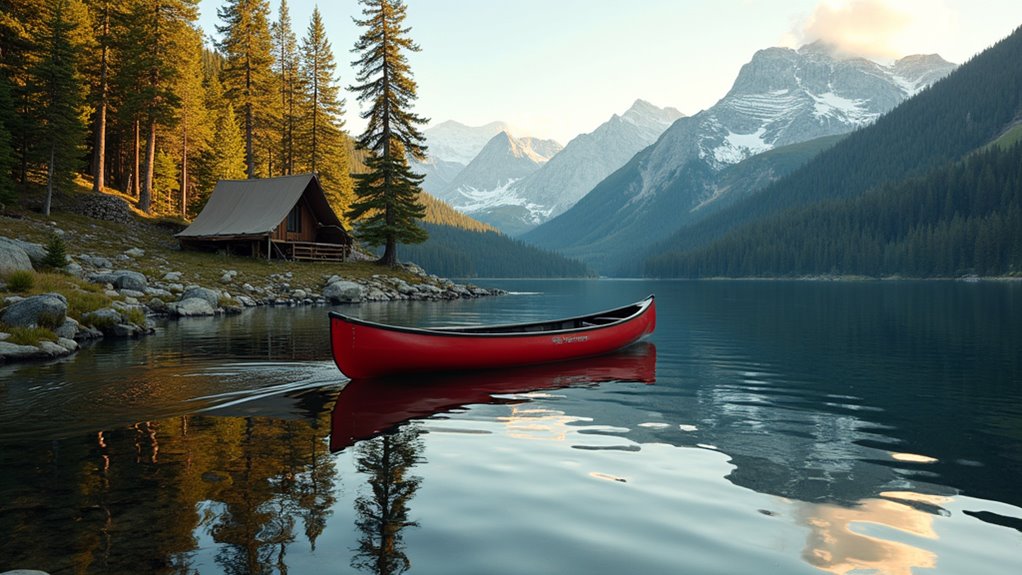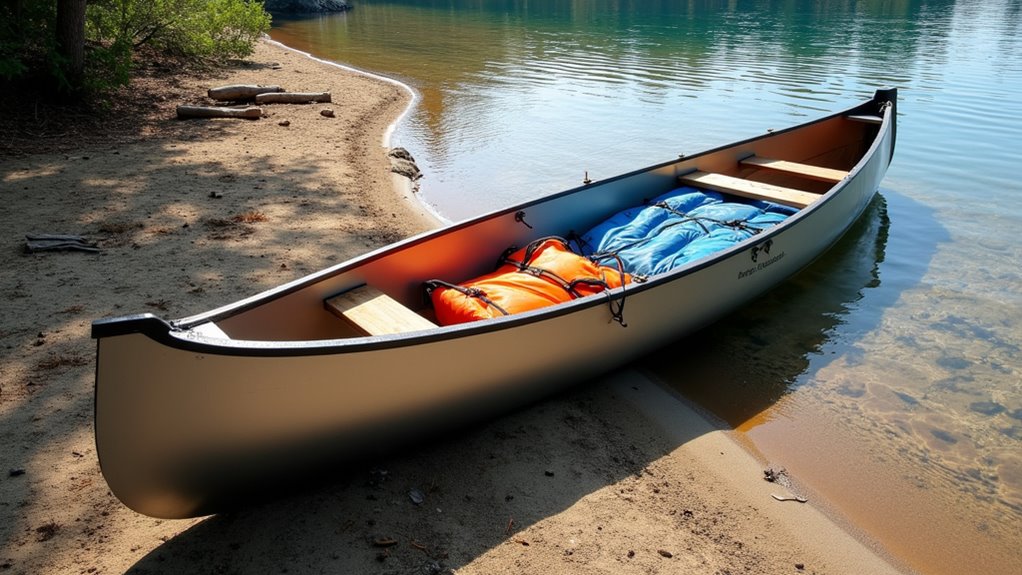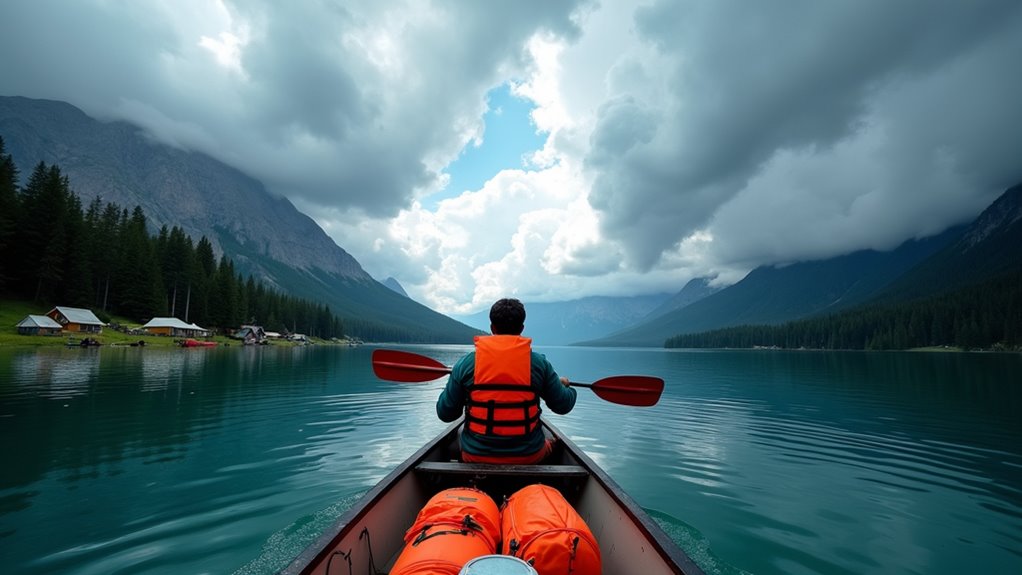Physical Address
304 North Cardinal St.
Dorchester Center, MA 02124
Physical Address
304 North Cardinal St.
Dorchester Center, MA 02124

Avoid canoe camping disasters by mastering these five essential basics that separate successful wilderness paddlers from those who struggle.
You’ve probably dreamed of paddling into the wilderness for weeks, but the reality is that canoe camping can quickly turn from paradise to disaster without proper preparation. Don’t worry though – mastering the basics isn’t as overwhelming as it seems. You’ll need to understand five key areas that separate successful canoe campers from those who end up soaked, lost, or scrambling in the dark. Once you’ve got these fundamentals down, you’ll wonder why you waited so long to try this incredible adventure.

When you’re planning your first canoe camping adventure, selecting the right gear can make the difference between a memorable trip and a miserable ordeal. Start with a reliable canoe that matches your skill level—aluminum models offer durability for beginners, while lightweight Kevlar suits experienced paddlers.
The right gear selection transforms your first canoe camping trip from potential disaster into an unforgettable wilderness experience.
You’ll need quality paddles (bring an extra), personal flotation devices, and waterproof dry bags for essentials.
Pack a portable camp stove, lightweight tent, and sleeping gear rated for expected temperatures. Don’t forget a first aid kit, water purification tablets, and a detailed map with compass.
Choose quick-dry clothing and avoid cotton materials. A headlamp beats flashlights for hands-free use around camp.
Remember: every ounce matters when portaging between lakes, so prioritize multi-purpose items and leave non-essentials behind. When selecting camping cookware, consider the size of your group and the duration of your trip to determine how much equipment you’ll actually need on the water.
While proper gear gets you to the water, understanding safety protocols and navigation skills will bring you home safely. Always inform someone about your planned route and expected return time before launching. Wear your PFD consistently – it’s your most critical safety tool. Check weather conditions and avoid paddling during storms or high winds.
Learn to read water features like currents, eddies, and obstacles. Practice basic rescue techniques, including self-rescue and assisted rescues. Carry a whistle for emergency signaling and know universal distress signals.
For navigation, bring a waterproof map and compass as backup to GPS devices. Study your route beforehand, identifying landmarks, campsites, and exit points. Start with familiar waters before tackling new territories. Trust your instincts – if conditions feel unsafe, don’t hesitate to turn back. When planning camping trips, coordinate your canoe routes with designated camping areas to ensure seamless transitions between paddling and overnight stays.

Proper packing transforms your canoe from an unstable, cramped vessel into a balanced touring machine that glides smoothly through the water. You’ll want to distribute weight evenly, placing heavier items like water and food low in the canoe’s center. Keep the heaviest gear closest to the hull’s bottom to lower your center of gravity.
Strategic weight distribution and low-center packing transforms an awkward canoe into a stable, responsive vessel that moves effortlessly across the water.
Pack essential items in waterproof dry bags – your sleeping bag, clothes, and electronics can’t afford to get soaked. Store frequently needed gear within easy reach, like snacks, water bottles, and your first aid kit.
Load the bow slightly lighter than the stern to help with steering and wind resistance.
Secure everything with bungee cords or rope. Loose gear creates dangerous projectiles if you capsize and makes paddling unnecessarily difficult.
Having the right essential camping gear can make all the difference in your canoe camping experience, so invest in quality equipment that serves multiple purposes and packs efficiently.
After paddling all day, you’ll want to find a campsite that offers both comfort and safety for the night ahead. Look for level ground at least 200 feet from water sources to protect wildlife and water quality.
Check for natural windbreaks like trees or rock formations that’ll shield your tent from harsh weather.
Avoid low-lying areas where water might collect during rain.
Scout for dead trees overhead that could fall during storms.
You’ll need access to water for cooking and cleaning, but don’t camp directly on the shoreline.
Clear away rocks, sticks, and debris before pitching your tent.
Set up your kitchen area downwind from sleeping quarters.
Store food properly in bear canisters or hang it high between trees to prevent unwanted wildlife visits.
Remember that canoeing itself is one of those recreational activities that provides an excellent workout while feeling like pure enjoyment rather than structured exercise.

Weather conditions can change rapidly on the water, turning a peaceful paddle into a dangerous situation within minutes. You’ll need to stay alert and prepared for anything nature throws your way.
Before launching, check local weather forecasts and radar patterns. Watch for darkening clouds, sudden wind shifts, or dropping temperatures. These signals often precede severe weather that could leave you stranded or in danger.
Essential emergency preparations include:
Stay flexible with your plans—it’s better to cut a trip short than face dangerous conditions. If you don’t own a canoe, consider whether renting or buying a used watercraft makes more sense for your camping frequency and budget.
You’ve got the blueprint for an unforgettable aquatic adventure! While Mother Nature might occasionally throw you a curveball or two, your preparation will turn potential mishaps into mere speed bumps. Don’t let the possibility of getting a little damp or facing unexpected detours discourage you—these moments often become your best stories. Pack smart, paddle confidently, and embrace whatever surprises await. Your canoe camping journey’s ready to launch whenever you are!